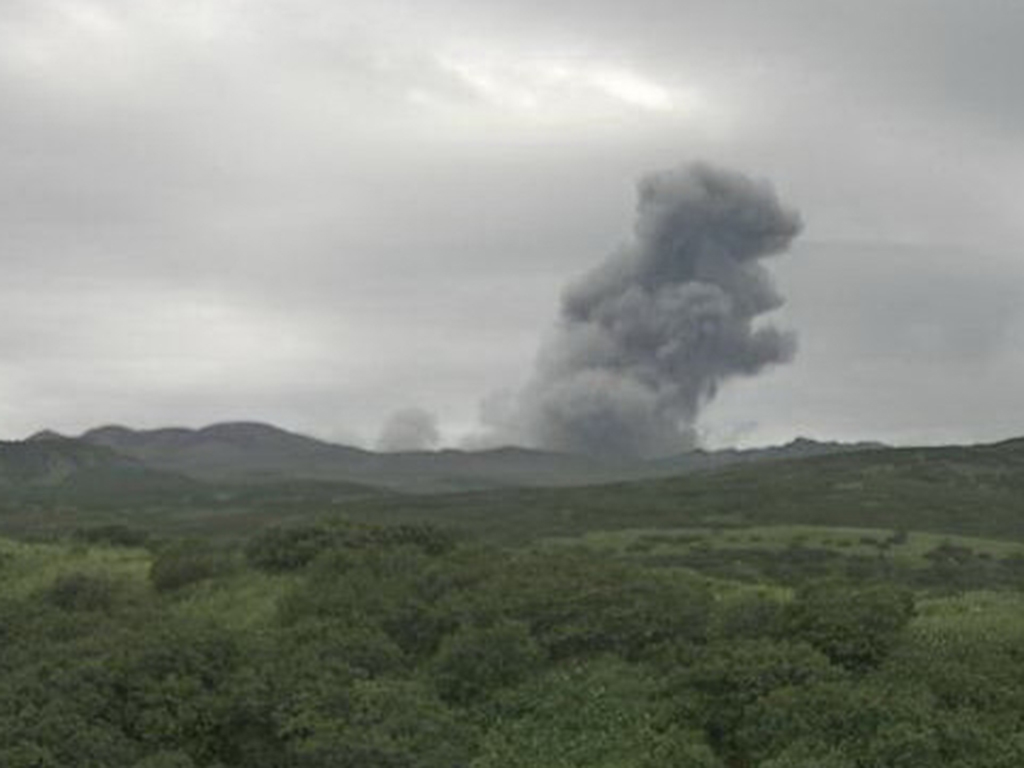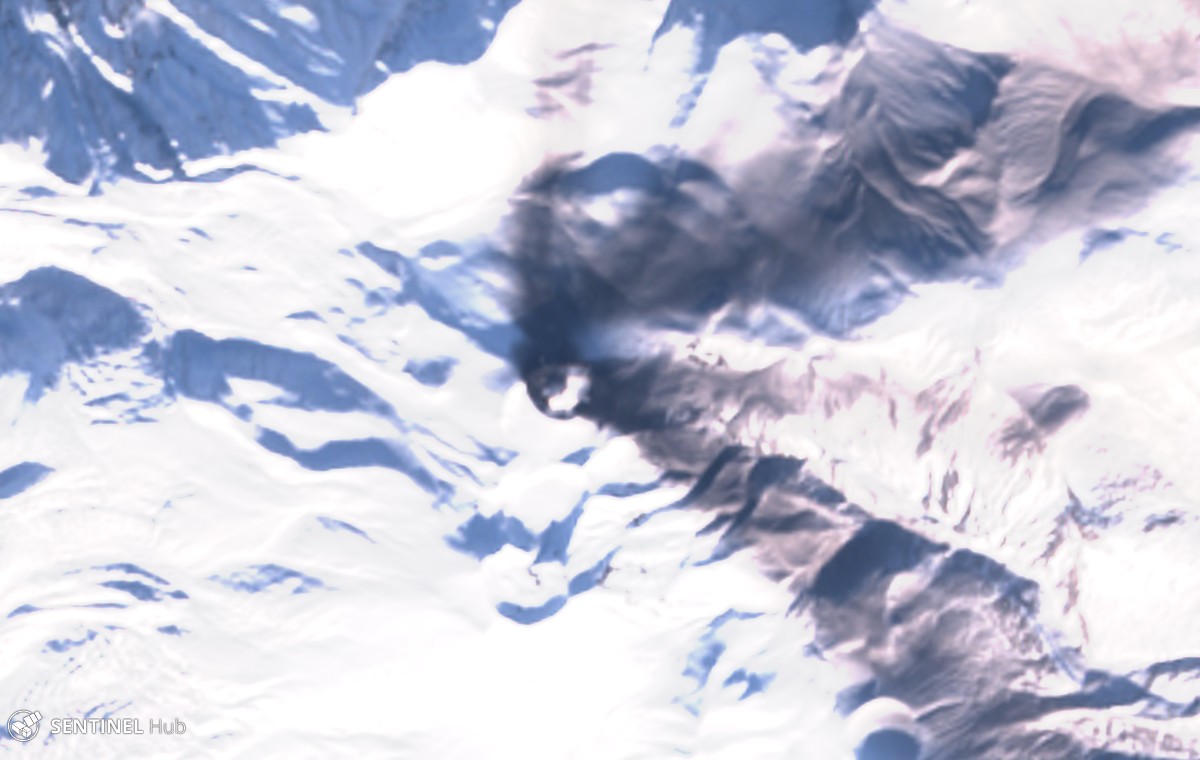Report on Ebeko (Russia) — December 2019
Bulletin of the Global Volcanism Network, vol. 44, no. 12 (December 2019)
Managing Editor: Edward Venzke.
Research and preparation by Paul Berger.
Ebeko (Russia) Frequent moderate explosions, ash plumes, and ashfall continue through November 2019
Please cite this report as:
Global Volcanism Program, 2019. Report on Ebeko (Russia) (Venzke, E., ed.). Bulletin of the Global Volcanism Network, 44:12. Smithsonian Institution. https://doi.org/10.5479/si.GVP.BGVN201912-290380
Ebeko
Russia
50.686°N, 156.014°E; summit elev. 1103 m
All times are local (unless otherwise noted)
Activity at Ebeko includes frequent explosions that have generated ash plumes reaching altitudes of 1.5-6 km over the last several years, with the higher altitudes occurring since mid-2018 (BGVN 43:03, 43:06, 43:12, 44:07). Ash frequently falls in Severo-Kurilsk (7 km ESE), which is monitored by the Kamchatka Volcanic Eruptions Response Team (KVERT). This activity continued during June through November 2019; the Aviation Color Code remained at Orange (the second highest level on a four-color scale).
Explosive activity during December 2018 through November 2019 often sent ash plumes to altitudes between 2.2 to 4.5 km, or heights of 1.1 to 3.4 km above the crater (table 8). Eruptions since 1967 have originated from the northern crater of the summit area (figure 20). Webcams occasionally captured ash explosions, as seen on 27 July 2019(figure 21). KVERT often reported the presence of thermal anomalies; particularly on 23 September 2019, a Sentinel-2 thermal satellite image showed a strong thermal signature at the crater summit accompanied by an ash plume (figure 22). Ashfall is relatively frequent in Severo-Kurilsk (7 km ESE) and can drift in different direction based on the wind pattern, which can be seen in satellite imagery on 30 October 2019 deposited NE and SE from the crater(figure 23).
Table 8. Summary of activity at Ebeko, December 2018-November 2019. S-K is Severo-Kurilsk (7 km ESE of the volcano). TA is thermal anomaly in satellite images. Data courtesy of KVERT.
| Date | Plume Altitude (km) | Plume Distance | Plume Directions | Other Observations |
| 30 Nov-07 Dec 2018 | 3.6 | -- | E | Explosions. Ashfall in S-K on 1, 4 Dec. |
| 07-14 Dec 2018 | 3.5 | -- | E | Explosions. |
| 25 Jan-01 Feb 2019 | 2.3 | -- | -- | Explosions. Ashfall in S-K on 27 Jan. |
| 02-08 Feb 2019 | 2.3 | -- | -- | Explosions. Ashfall in S-K on 4 Feb. |
| 08-15 Feb 2019 | 2.5 | -- | -- | Explosions. Ashfall in S-K on 11 Feb. |
| 15-22 Feb 2019 | 3.6 | -- | -- | Explosions. |
| 22-26 Feb 2019 | 2.5 | -- | -- | Explosions. Ashfall in S-K on 23-26 Feb. |
| 01-02, 05 Mar 2019 | -- | -- | -- | Explosions. Ashfall in S-K on 1, 5 Mar. |
| 08-10 Mar 2019 | 4 | 30 km | ENE | Explosions. Ashfall in S-K on 9-10 Mar. |
| 15-19, 21 Mar 2019 | 4.5 | -- | -- | Explosions. Ashfall in S-K on 15-16, 21 Mar. |
| 22, 24-25, 27-28 Mar 2019 | 4.2 | -- | -- | Explosions. Ashfall in S-K on 24-25, 27 Mar. |
| 29-31 Mar, 01, 04 Apr 2019 | 3.2 | -- | -- | Explosions. Ashfall in S-K on 31 Mar. TA on 31 Mar. |
| 09 Apr 2019 | 2.2 | -- | -- | Explosions. |
| 12-15 Apr 2019 | 3.2 | -- | -- | Explosions. TA on 13 Apr. |
| 21-22, 24 Apr 2019 | -- | -- | -- | Explosions. |
| 26 Apr-03 May 2019 | 3 | -- | -- | Explosions. |
| 04, 06-07 May 2019 | 3.5 | -- | -- | Explosions. TA on 6 May. |
| 12-13 May 2019 | 2.5 | -- | -- | Explosions. TA 12-13 May. |
| 16-20 May 2019 | 2.5 | -- | -- | Explosions. TA on 16-17 May. |
| 25-28 May 2019 | 3 | -- | -- | Explosions. TA on 27-28 May. |
| 03 Jun 2019 | 3 | -- | E | Explosions. |
| 12 Jun 2019 | -- | -- | -- | TA. |
| 14-15 Jun 2019 | 2.5 | -- | NW, NE | Explosions. |
| 21-28 Jun 2019 | -- | -- | -- | TA on 23 June. |
| 28 Jun-05 Jul 2019 | 4.5 | -- | Multiple | Explosions. TA on 29 Jun, 1 Jul. |
| 05-12 Jul 2019 | 3.5 | -- | S | Explosions. TA on 11 Jul. |
| 15-16 Jul 2019 | 2 | -- | S, SE | Explosions. TA on 13-16, 18 Jul. |
| 20-26 Jul 2019 | 4 | -- | Multiple | Explosions. TA on 18, 20, 25 Jul |
| 25-26, 29 Jul, 01 Aug 2019 | 2.5 | -- | Multiple | Explosions. |
| 02, 04 Aug 2019 | 3 | -- | SE | Explosions. TA on 2, 4 Aug. |
| 10-16 Aug 2019 | 3 | -- | SE | Explosions. TA on 10, 12 Aug. |
| 17-23 Aug 2019 | 3 | -- | SE | Explosions. TA on 16 Aug. |
| 23, 27-28 Aug 2019 | 3 | -- | E | Explosions. TA on 23 Aug. |
| 30-31 Aug, 03-05 Sep 2019 | 3 | -- | E, SE | Explosions on 30 Aug, 3-5 Sep. TA on 30-31 Aug. |
| 07-13 Sep 2019 | 3 | -- | S, SE, N | Explosions. Ashfall in S-K on 6 Sep. TA on 8 Sep. |
| 13-15, 18 Sep 2019 | 2.5 | -- | E | Explosions. TA on 15 Sep. |
| 22-23 Sep 2019 | 3 | -- | E, NE | Explosions. Ashfall in S-K. |
| 27 Sep-04 Oct 2019 | 4 | -- | SE, E, NE | Explosions. |
| 07-08, 10 Oct 2019 | 2.5 | -- | E, NE | Explosions. Ashfall in S-K on 4-5 Oct. Weak TA on 8 Oct. |
| 11-18 Oct 2019 | 4 | -- | NE | Explosions. Ashfall in S-K on 15 Oct. Weak TA on 12 Oct. |
| 18, 20-21, 23 Oct 2019 | 3 | -- | N, E, SE | Explosions. Weak TA on 20 Oct. |
| 25-26, 29-30 Oct 2019 | 2.5 | -- | E, NE | Explosions. Weak TA on 29 Oct. |
| 02-06 Nov 2019 | 3 | -- | N, E, SE | Explosions. |
| 11-12, 14 Nov 2019 | 3 | -- | E, NE | Explosions. |
| 15-17, 20 Nov 2019 | 3 | -- | SE, NE | Explosions. |
| 22-23, 28 Nov 2019 | 2.5 | -- | SE, E | Explosions. Ashfall in S-K on 23 Nov. |
 |
Figure 20. Satellite image showing the summit crater complex at Ebeko, July 2019. Monthly mosaic image for July 2019, copyright 2019 Planet Labs, Inc. |
The MIROVA (Middle InfraRed Observation of Volcanic Activity) analysis of MODIS satellite data detected four low-power thermal anomalies during the second half of July, and one each in the months of June, August, and October; no activity was recorded in September or November MODVOLC thermal alerts observed only one thermal anomaly between June through November 2019.
Geological Summary. The flat-topped summit of the central cone of Ebeko volcano, one of the most active in the Kuril Islands, occupies the northern end of Paramushir Island. Three summit craters located along a SSW-NNE line form Ebeko volcano proper, at the northern end of a complex of five volcanic cones. Blocky lava flows extend west from Ebeko and SE from the neighboring Nezametnyi cone. The eastern part of the southern crater contains strong solfataras and a large boiling spring. The central crater is filled by a lake about 20 m deep whose shores are lined with steaming solfataras; the northern crater lies across a narrow, low barrier from the central crater and contains a small, cold crescentic lake. Historical activity, recorded since the late-18th century, has been restricted to small-to-moderate explosive eruptions from the summit craters. Intense fumarolic activity occurs in the summit craters, on the outer flanks of the cone, and in lateral explosion craters.
Information Contacts: Kamchatka Volcanic Eruptions Response Team (KVERT), Far Eastern Branch, Russian Academy of Sciences, 9 Piip Blvd., Petropavlovsk-Kamchatsky, 683006, Russia (URL: http://www.kscnet.ru/ivs/kvert/); Institute of Volcanology and Seismology, Far Eastern Branch, Russian Academy of Sciences (IVS FEB RAS), 9 Piip Blvd., Petropavlovsk-Kamchatsky 683006, Russia (URL: http://www.kscnet.ru/ivs/eng/); Sentinel Hub Playground (URL: https://www.sentinel-hub.com/explore/sentinel-playground); Planet Labs, Inc. (URL: https://www.planet.com/); MIROVA (Middle InfraRed Observation of Volcanic Activity), a collaborative project between the Universities of Turin and Florence (Italy) supported by the Centre for Volcanic Risk of the Italian Civil Protection Department (URL: http://www.mirovaweb.it/); Hawai'i Institute of Geophysics and Planetology (HIGP) - MODVOLC Thermal Alerts System, School of Ocean and Earth Science and Technology (SOEST), Univ. of Hawai'i, 2525 Correa Road, Honolulu, HI 96822, USA (URL: http://modis.higp.hawaii.edu/).




